L'Arc de Triomphe
- Address: Place Charles de Gaulle, 75008 Paris, Francia
- Tags:
 What to see Paris,
Paris,
France
What to see Paris,
Paris,
France
- Telephone: +33 1 55 37 7
- Website: arc-de-triomphe.monuments-nationaux.fr
L'Arc de Triomphe

The Arc de Triomphe in Paris, the largest triumphal arch in the world, is located in the centre of Place Charles de Gaulle-Étoile on the far northwest of Avenue des Champs-Elysées.
The enormous arch was commissioned by Napoleon in honour of his Grande Armée and 128 victorious battles between 1805 and 1809.
However, Napoleon's ideas were more ambitious than this. Commissioned in 1806, the arch was far off completion when the conquering machine that was France came to a halt at the Battle of Waterloo in 1815.
Finally completed in 1836, the Arc de Triomphe was dedicated to honour all the French soldiers and generals who died in the revolutionary and Napoleonic Wars. . The victory of France in both World Wars were celebrated here, but the German armies marched through the arch and the Champs-Elysées after the Franco-Prussian war of 1871 and at the outbreak of war in 1940.

Beneath the arch burns an eternal flame for an unknown French soldier who died in World War One, and a huge tricolour French flag usually hangs from the arch. Bathed in soft light at night, you really feel as if the arch embodies some of the greatness of French civilisation.
After admiring the arch from the edge of the large Place Charles de Gaulle, use the underground passageways to reach the arch in the centre of the busy roundabout. Buy your entrance ticket, and then climb the 284 steps to the top (there is also a lift), located 50 metres above the pavement.
Choose a sunny day for your visit if at all possible. You get the best pictures of the Eiffel Tower in the morning, as it's lit up by the sun at this time. Sunset, where the lights are coming on all over Paris, is also a great time for photos.
After you arrive at the top terrace, visit the large rooms housing expositions which tell the history of the arch. There are toilets here, though the queues to use them are usually very long.
In the upper part of the terrace, look southeast down the Avenue des Champs-Elysées to see Place de la Concorde in the distance, slightly further than the Jardin des Tuileries, the Arc de Triomphe du Carrousel and the Palais du Louvre.

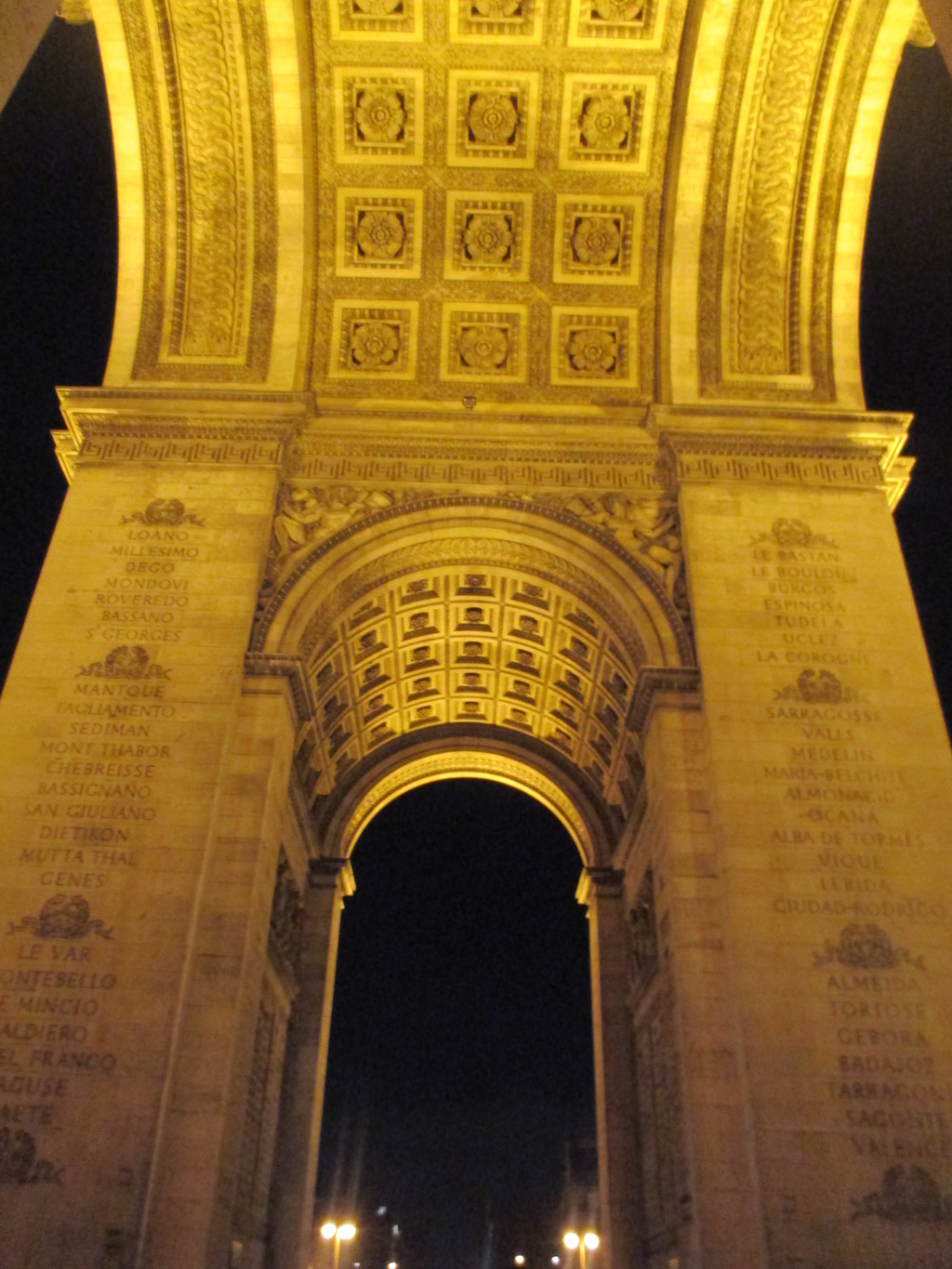
Photo gallery
Content available in other languages
- Español: Arco del Triunfo
- Italiano: L'Arco di Trionfo
The majestic Arc De Triomphe
The archway with a height of 49, 546 meters is the most powerful triumphal arch in the world. When Napoleon Bonaparte won the Austrian War of Independence, the triumphal arch in Paris resolved to swing triumph over the arc de Triomphe to Holme Shay. The arc is decorated with the crown of the army of the French Army, 558 generals. The Triumphal Arch is a central element in the Louvre, the Soglasia Plateau and the Big Arch of the Defense in the modern district. Napoleon as an Emperor and his new wife Marie-Louise became the next symbol of Paris.
The construction of the monument began in 1806 and lasted for 30 years. The situation during that time was constantly stagnant, as the Emperor had to shatter the blows of the raiders. Because of that, the construction of the arch lasted so long. The most amazing thing for me is the decoration of arc with giant representations of battles: Austerlitz, Marseleza, Victory of Abukire, Soprotivlenie, Triumph Napoleon, Crossroads of Arctic Bridge, Pohoroni Marso, Mir, Bithwe at the Cemapse, "Vzyatie Alexandria".
The triumphal arch of Paris can be seen as a memorial plaque, and a gem of France. The building was completed in 1836, while the emperor was already dead.
The triumphal arch in Paris is a symbol of the city, with the Eiffel Tower and the Notre-Dame Cathedral of Paris.
Cultural significance of the Arc de Triomphe
Inside the Arc de Triomphe is a museum that documents its history, architectural design and construction. One of the advantages of it is the use of multimedia presentations with instructions, thanks to which the visitors understand the concepts better. The most amazing for me is the observation deck on the top where we have a wonderful view of the city and the "Triumphal Avenue" geometry. In order to reach the top you can either take an elevator or walk up 234 steps. Of course, walking is a bit tiring but more interesting as during the climb you see every detail of the construction.
The road goes in a straight line from the new Arc de la Défense to the Arc de Triomphe and onwards toward the center of the dity, passing many of Paris' most famous vistats along the way.
The graveyard of a ghost soldier
The tombstone ceremony of the "awakening" night lamp is held Every Sunday evening. The mogul of the Unknown Soldier is in the head of the arch, and was constructed in 1921. This soldier survived during the first World War. Here, on every Armistice Day (November 11), the President of the Republic lays a ceremonial wreath, in which burns an eternal flame in honor of the heroes-soldiers who died in the First World War.
As I have learned France was the first among the European countries to revive the tradition of Ancient Rome by lighting an eternal fire and giving it a different meaning. In Rome there was only a sacred fire that burned only in the temple of the goddess Vesta.
The arch attracts the attention of millions of tourists from all over the world, as well as the Parisians, who adore strolling under it. The sense of harmony and freedom is seen in the mighty walls of the arch, which attracts the glances of people passing by.
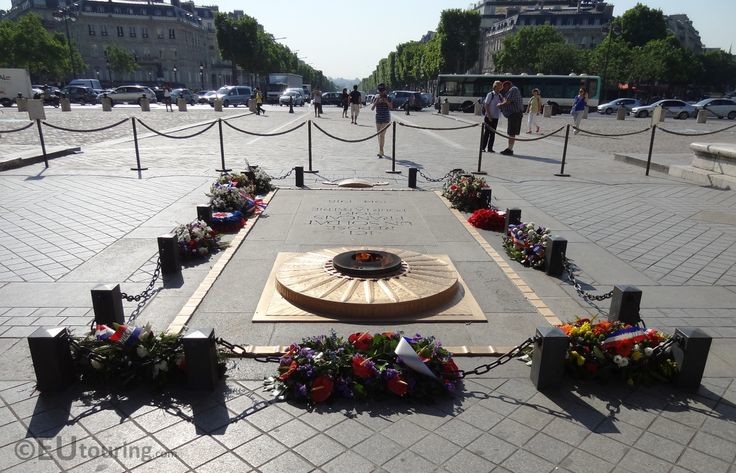
The tomb of the unknown soldier,
Interesting facts
The Square of the star is considered to be one of the most dangerous crossroads in the world, and in case of an accident, not all insurance companies are ready to compensate for the damage.
There are five triumphal arches in Paris, three of which are located in a straight line: the Arc de Triomphe of Carrousel, the Arc de Triomphe on the Place of the Star and the Grand Arch of the Defense. Only around the arch of the Star there is organized traffic.
One of the interesting facts about the Arc de Triomphe is that Parisians claim that twice a year, on May 10 and August 1, the sun sets just on the historical axis and the sunset can be seen through the arches. I didn’t manage to see if it is true or not but I do know that on May 10, 1994, hundreds of thousands of people watched the solar eclipse through the archway.
The idea of creating the Arc de Triomphe belongs to Bonaparte, who wished to immortalize his victories. Jean-François Chalgrin was appointed as architect, and he was inspired by examples of the triumphal arches of ancient Rome. An interesting historical fact is that the first stone was laid by the emperor's own hands in the day of his birth. But neither Napoleon nor Chalgrin was lucky enough to see the whole creation because the arch was constructed over for thirty years!
July 29, 1836, in Paris is considered the "birthday" of the Arc de Triomphe on the Square of the Star - on this day the grand opening of the main Parisian gates took place, around which there are so many legends today. In order to avoid the occurrence of accidents, protective nets have been stretched to guard against falling stones. The main causes of the gradual destruction of the arch is considered to be the atmosphere. And in order to save the monument, a number of precautions were carried out; part of the funds came from donations from organizations and individuals.
Architecture
As I mentioned the arch rises to 49 meters and decorates Paris with its elegance and harmony. The Arc de Triomphe of Paris differs from other arches. First of all, it is decorated with a large number of various elements.
The triumphal arcade is full of historical and symbolic significance, but it does not have fine memorable architecture. I would characterize it as a building with impressive dimensions (49 m high, 44 m wide, 29 m) and hawthorne framework. In the background, the Arc is surrounded by parcels. The backdrop is decorated with four sculpted groups, reflecting significant events in France - Marseille, the Triumph, Soprotivlenie, and Mir. Most of all I liked "Marseillaise", or "A Volunteer Campaign"-a dynamic, passionate composition depicting the warriors performing a campaign against the Prussian troops. It shows the soldiers in uniform marching in a single unit. Their movement is captained by the figure of the winged goddess-it is an allegory of freedom, homeland, victory, revolution and the folk song of the Marseillaise.
The archives, on the pillars, are engraved with the names of the French soldiers and the names of the militants. It is engraved with names of generals who commanded French troops during Napoleon's regime, who won during the Revolutionary and Napoleonic periods. The names of less important victories, as well as those of 558 generals, can be found on the inside walls. The Arc is surrounded by 100 granite tubes, with two chains.
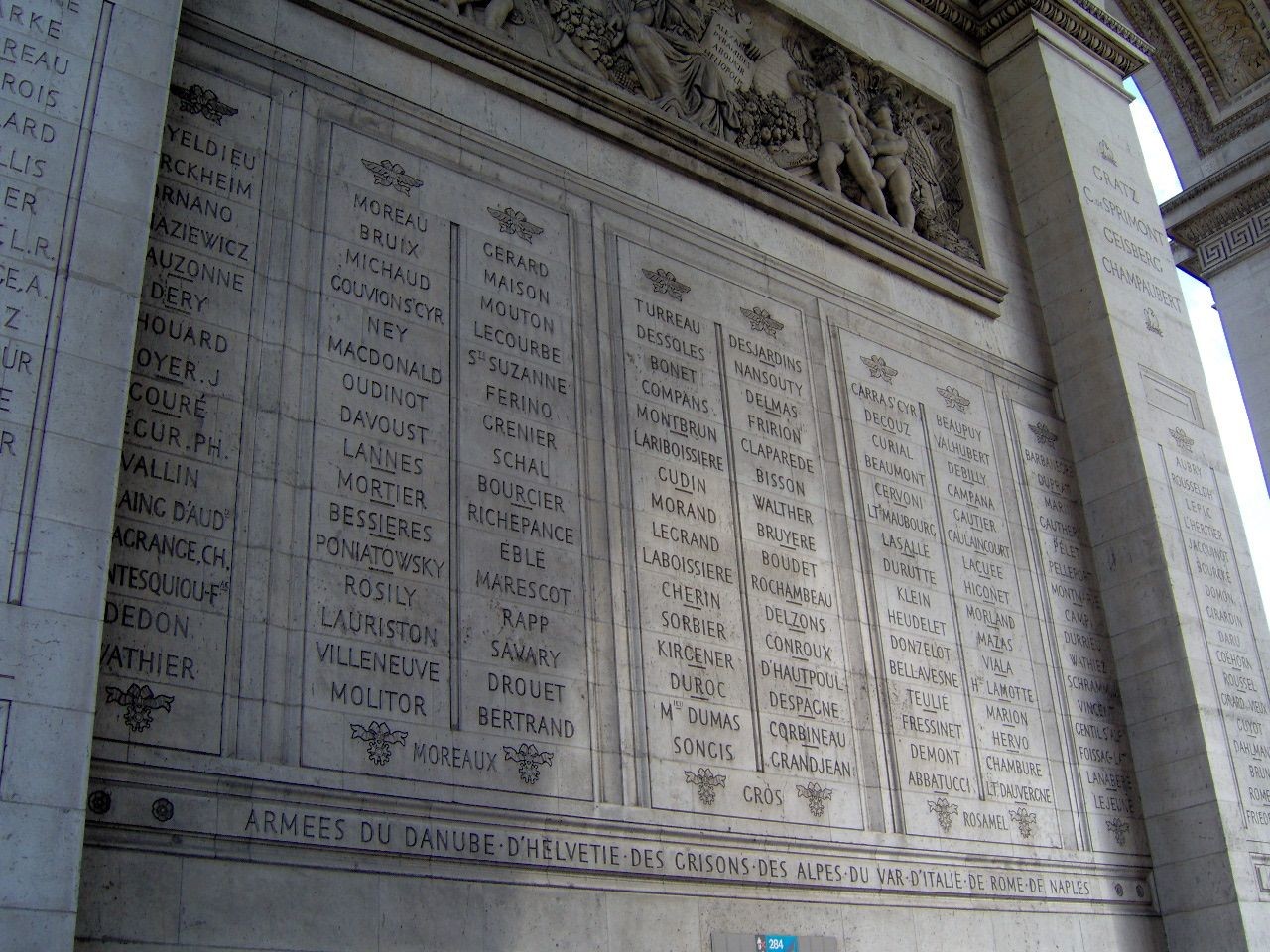
On the left face of the arch is Corot's The Triumph of Napoleon.
On the right face of the arch is Francois Rude's The Departure of the Volunteers of 1792 (or "La Marseillaise").
Above these groupings on the faces of the arch are bas reliefs in rectangular frames. On the Neuilly side the capture of Alexandria is shown (left below) with Kleber, standing on the city walls, urging his troops forward. The right hand bas-relief (center below) depicts the crossing of the Arcole Bridge. Napoleon with the drummer boy advances against the Austrians. Soldiers are running behind their general whose profile stands out quite clearly against the folds of the flag. The Neuilly side (below) illustrates the return of the army, with Peace and Abundance crowning the men. The attic is decorated with 30 shields, each of which is inscribed with the name of a victory. The parapet has sculpted heads of Medusa.
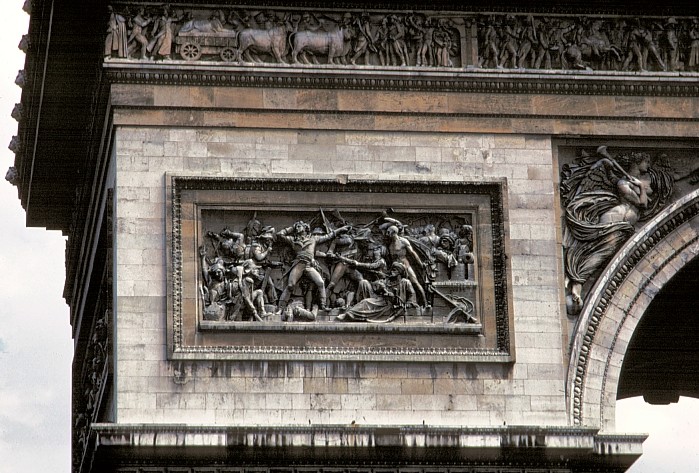
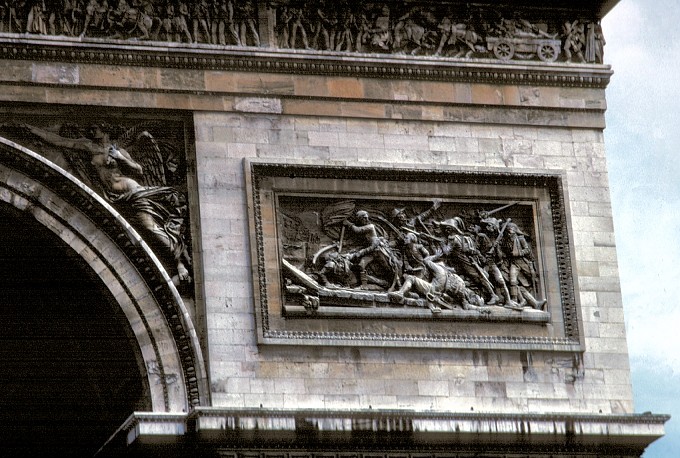
In the center Peace is represented with a man putting his sword back into his sheath and peasants are getting back to work; on the right, there is Resistance with a naked soldier defending his family.
How can you go up to the Triumph Arch?
The arch is located at the end of the legendary Parisian Avenue - the Champs Elysees. You can get here thanks to the metro. And to get to the top of the arch you need to take an elevator or a spiral staircase. It is worth a visit since it offers a wonderful view of the picturesque panorama of the city.
You can get there by:
The open hours of the Triumphal arch are: from April 1 to September 30, from 10 to 23:00, and from October 1 to March 31, from 10:00 to 22:30. The visit costs 9 €, but children under the age of 18 are free of charge ( adult accompaniment is compulsory).
The triumphal arch is the symbol of the great emperor with his brutal army. Not everyone knows the origin of the glory of a "triumph". The triumph singled out the great men of the army. Triumph-it is still the best and most rewarding award till now.
During your observations you can come across unexpected historical and modern discoveries, feel the Parisian atmosphere and have positive emotions!
This structure remains extremely famous in the world. Despite the many years of construction work the arch remains an outstanding landmark and will continue to be such in the future. The French army under the command of Napoleon had its significance for France at that time and will remain forever in its history.
This monument is considered a symbol of Paris, along with the Notre Dame Cathedral and the Eiffel Tower. A lot of tourists come here constantly. Paris is the only city in which you can imagine a triumphal arc. And it is one of the attractions of the world about which you can talk for hours and continue long after. My conclusion is that a tourist who has arrived in Paris, or even a businessman who has visited France on a business trip, primarily goes either to the Arc de Triomphe or to the Eiffel Tower.
Photo gallery
Content available in other languages
- Français: L'Arc de Triomphe majestueux
- Español: El majestuoso Arco de Triunfo
- Italiano: Il maestoso Arco di Trionfo
A great view
A typical tourists go-see in Paris, the Arc de Triomphe is a very central and touristy attraction. Even so, its worth a look.

You can go in via an underground tunnel that takes you under THAT roundabout (if you drive you should try doing it just for the experience but it is harrowing) and then you have to queue up with the hundreds of tourists who go here daily.

Luckily, this is one of the Paris attractions that is free for European Citizens under the age of 25 (so do try to visit it and many other museums and landmarks in Paris before Brexit).
There is a very long, narrow, spiral staircase to climb up to the top, although there is a lift if need be (with a long queue).

At the top there is a museum type area with information about the history of the Arc, with maps and photos and also an array of French military uniforms throughout the ages. You can also use the interactive map to see where similar Arcs are located worldwide.
From the top there is a cracking view of the Champs Elysees and central Paris, including the Eiffel Tower. This is a great photo opportunity if you go up on a sunny day, and there are telescopes to look at things in more detail if you wish. You can even see the Sacre Coeur and Notre Dame, although from a distance and not in as much detail.
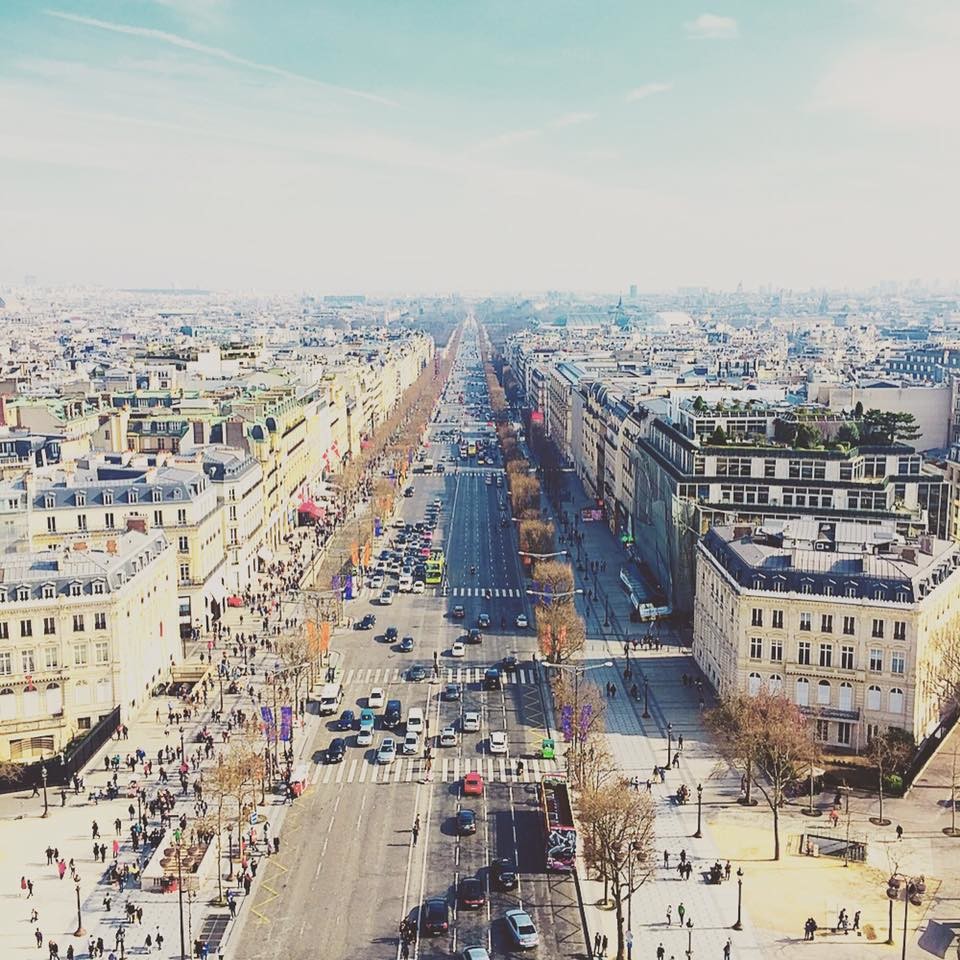
Don't go here hungover as the stairs will kill you.
Photo gallery
Content available in other languages
- Français: Une superbe vue
- Español: Unas vistas espectaculares
- Italiano: Una vista magnifica
Arc de Triomphe, Paris
The Arc de Triomphe [in French, l’Arc de Triomphe de l’Étoile] is another of the famous symbols of Paris, and is located in the centre of the Place Charles de Gaulle, at one end of the Champs-Élysées. This was the first triumphal arch that I ever saw, and I have since seen many more in other cities, but I think this remains to be the most famous amongst them all.

This arch was built by order of Napoléon Bonaparte to commemorate the victory of the French in the Battle of Austerlitz, as he promised his soldiers that they would return home under triumphal arches. It measures 50 metres tall, 45 metres wide, and 22 metres deep.
As you will be able to see, it is sat right in the middle of the Place Charles de Gaulle (which was previously known as the Place de l’Etoile), but it is surrounded by a roundabout used by motorists, so there is an underpass that you can use that will take you to the city centre. I don’t know if you would want to walk along the side of the road because they drive like maniacs in Paris.
At first, I wasn't intending on going up to the arch’s lookout point, as I had already paid to go up the Eiffel Tower. However, by chance, I discovered that it was free for 18-25 year olds who are resident in the EU to go up (as well as under 18s), which is the case at many monuments; if not, it would cost 9. 50€. The stairs made the climb up seem endless to me - I think that there are almost 300 of them - but it was very much worth it in the end.
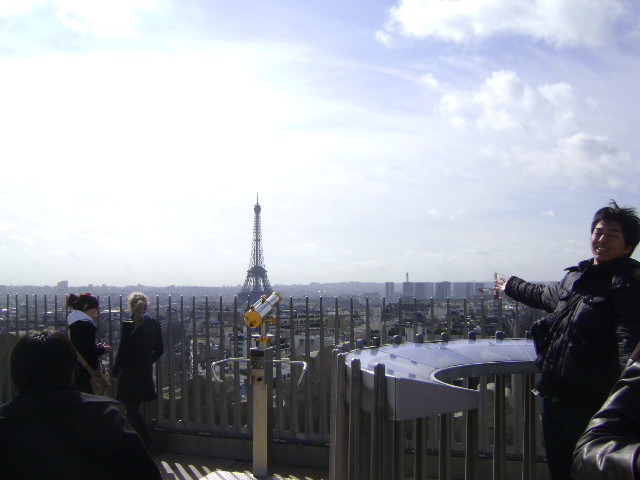
It has some spectacular views of Paris, especially of the Eiffel Tower and of La Défense financial district. In addition to the terrace, there is also a small museum, a miniature arch and facts about the monument.
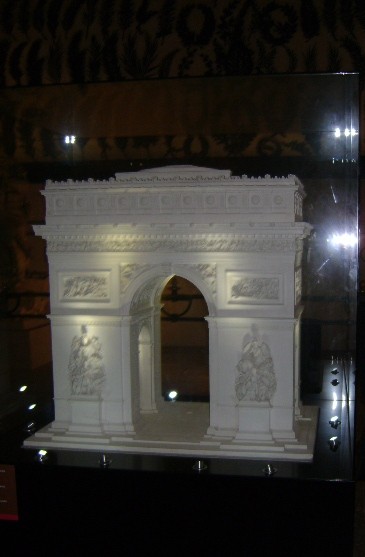
If you can, you have to go and see the Arc de Triomphe at night, as it looks even more elegant than it does during the day.
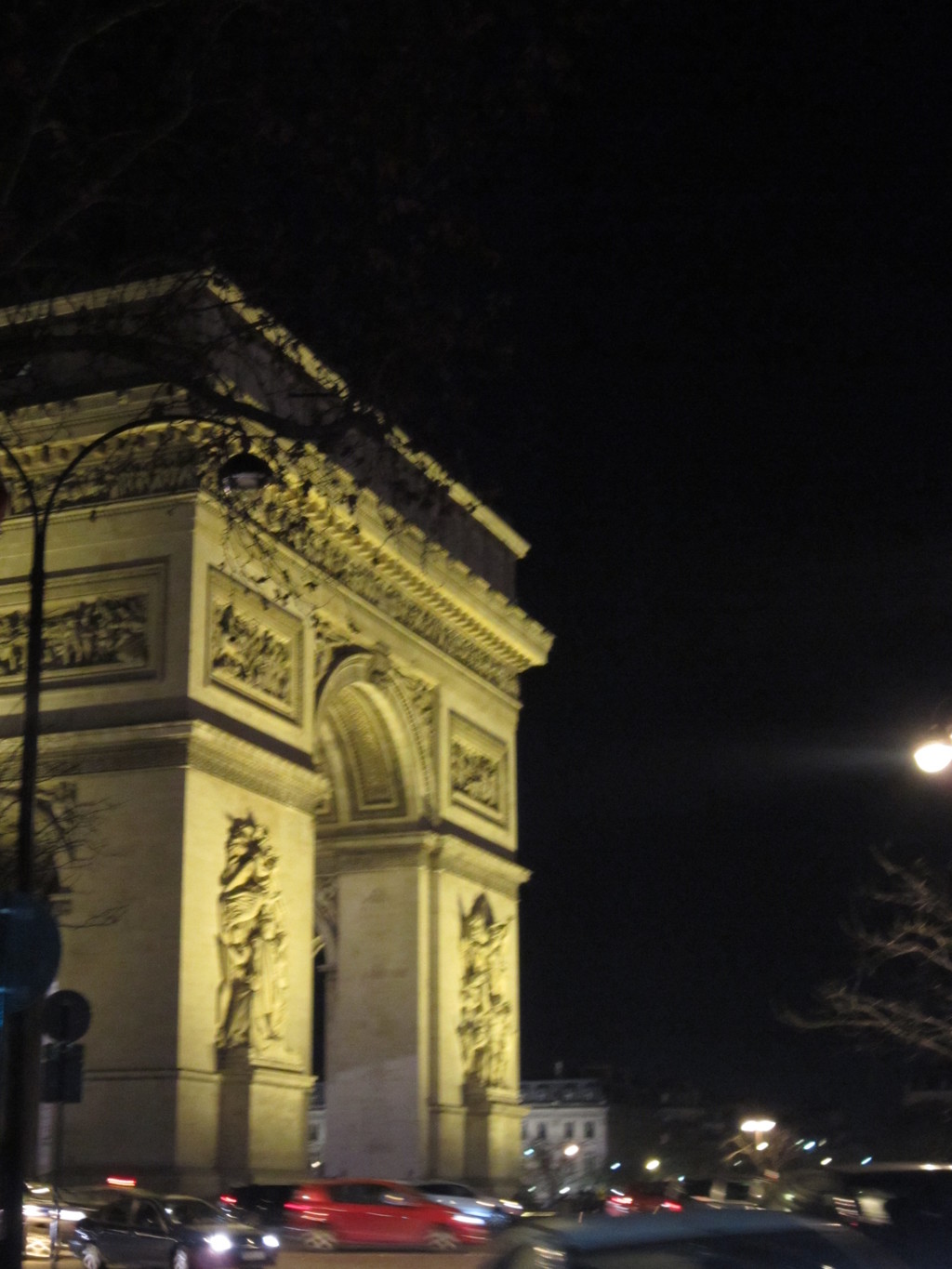
To get there via the city’s metro system, the closest stop is “Charles de Gaulle-Etoile”, which is served by lines 1, 2 and 6. You could equally take line A of the RER suburban train and alight at the same stop. There is also the option of catching the bus, or even walking, as it is close to all of the other popular attractions in the city.
If you are looking for something else, or perhaps you are thinking of spending New Year's Eve in Paris, check out this post!
Photo gallery
Content available in other languages
- Español: Arco del Triunfo de París
- Italiano: L'Arco di Trionfo di Parigi
- Français: L'Arc de Triomphe de Paris
Rate and comment about this place!
Do you know L'Arc de Triomphe? Share your opinion about this place.






























